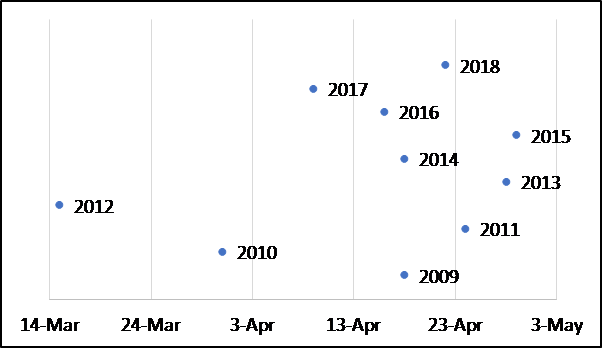Soil temperatures and planting timing – Part 2 of 3: Tracking soil temperature trends
A look at soil temperatures in Michigan in the last 10 years gives a glimpse into when soils typically reach optimum levels for seedling emergence.

In Part 1 of this series, the topic of optimal soil temperature for seed germination and emergence was addressed. In this part, we will look at the impacts of sub-optimal temperatures, particularly those that are cool. The calculations for modified growing degree days (GDD) with a base of 50 degrees Fahrenheit is because little biological activity (but not none) is taking place in the seed of most crop species below 50 F. The base is not arbitrary, but it is also not an on-off switch—the warmer the soil temperatures are (up to a point), the better the germination and emergence will be.
When can producers expect soil temperatures to reach these levels in Michigan? There are numerous anecdotal and science-based methods for choosing the right time to plant, but knowing the actual soil temperature in the field is one of the best indicators. Michigan State University’s Enviroweather system of weather stations provides a wealth of information on current and historical weather data as well as other useful crop-specific tools. As an example of when soils begin to warm up, data for the Coldwater station from 2009 to the present are shown in Figure 1.
A couple of interesting features of these Figure 1 graphs can be seen. First, in all but one year (2012) in the past decade, soil temperatures have reached 50 F and then fallen below that threshold for three to 15 days (average of eight days) before rising again. This points to the need for patience and knowing historical trends. Second, though no two years are ever the same, a trend and a range of dates can be obtained for when soils have warmed to and remained above 50 F. These dates for the Coldwater station are shown in Figure 2. If 2012 is removed as an outlier, the range of dates is March 31 to April 29, with April 20 being the average for this decade.

According to the data presented in Part 1 of this series, the optimum temperature for corn germination and emergence is in the mid-70s. Average soil temperatures like this were not seen until June in most months at Coldwater. Does this mean farmers should be waiting until then to plant? No, and in fact several MSU Extension articles (When is the best time to plant corn in Michigan?, Earlier planting dates are key for higher soybean yields) and published research (Nafziger, 1994; Lindsey and Thomison, 2016; Abendroth et al., 2017; Long et al., 2017) point to dates between late-April and mid-May as the optimum timing for planting corn and soybean in southern and central Michigan for highest yields.
If it is mid- to late-April and soil temperatures are near or above 50 F, and the 8-14 day weather outlook predicts warm temperatures, your risk of experiencing yield-reducing conditions are comparatively low. If, however, the forecast is for cold and wet conditions, the risk is higher and the likelihood of requiring a replant is higher. Other factors to keep in mind with regards to soil conditions for planting include soil moisture, tillage, residue coverage, ability to use irrigation and others. Individual growers will need to assess their own tolerance of risk when making early planting decisions.
The longer the seed is in the ground, the more potential exists for something to go wrong—heavy rains that cause flooding and anaerobic conditions, imbibitional chilling, seed predation by insect pests (seedcorn maggot, white grubs, wireworms) and infection by various soil-borne pathogens (Pythium species, some Fusarium species) . Using a seed treatment that includes two or more active fungicide ingredients—for example, mefenoxam against Pythium and fludioxonil or a strobilurin against Fusarium—and an effective insecticide is advised, particularly for corn. The further below optimum soil temperatures are at planting, the more likely an effective seed treatment will provide an economic return.
In Part 3 of this series, data from a 2018 study of soil temperatures in southwest Michigan will be shown and compared with those from the nearest Enviroweather station to test how representative the temperatures at these stations are for soils in that region.
Citations
- Abendroth, L.J. et al. 2017. Crop, Forage and Turfgrass Management, Vol. 3.
- Lindsey, A.J. and Thomison, P.R. 2016. Drought-Tolerant Corn Hybrid and Relative Maturity Yield Response to Plant Population and Planting Date. Agronomy Journal, 108:229–242.
- Long N.V. et al. 2017. Maize Yield and Planting Date Relationship: A Synthesis-Analysis for US High-Yielding Contest-Winner and Field Research Data. Frontiers in Plant Science, 8:2106.
- Nafziger, E.D. 1994. Corn Planting Date and Plant Population. Journal of Production Agriculture, 7(1):59-62.



 Print
Print Email
Email






